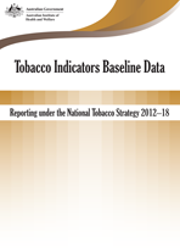Summary
This report presents baseline data for the outcome indicators listed under Part Seven of the National Tobacco Strategy (NTS) 2012-2018, and for an additional 6 indicators that were agreed to when the reporting framework was developed (see Chapter 1 of this report for more information) in consultation with the Intergovernmental Committee on Drugs National Expert Reference Group on Tobacco.
As no single tobacco-related data collection is sufficient to inform all the indicators, different data sources and collection years (from 2007-08 to 2011) have been used to report baseline data against these indicators.
Baseline data, against which future data can be compared, will enable progress to be measured and desired outcomes to be assessed. A mid-term review is expected to begin in late 2015 to assess improvements over time and determine whether desired outcomes are being achieved.
| Indicator | Baseline data |
|---|---|
| Indicator 1: Fewer young people smoking regularly | In 2011, among secondary school students aged 12–17, 6.7% smoked tobacco at least once in the previous week. |
| Indicator 2: Fewer young people making the transition to established patterns of smoking | In 2011, 3.5% of secondary school students aged 12–17 had smoked more than 100 cigarettes in their lifetime. In 2010, nearly 3 in 10 (29%) young adults aged 18–24 had smoked more than 100 cigarettes in their lifetime. |
| Indicator 3: Fewer adults smoking regularly | In 2007–08, nearly 1 in 5 (18.9%) adults (aged 18 or older) smoked tobacco daily. |
| Indicator 4: More smokers attempting to quit | In 2010, almost half (45%) of adult smokers had made an attempt to quit smoking in the previous 12 months. |
| Indicator 5 .1: Fewer women smoking while pregnant | Of women who gave birth in 2011, 13.2% smoked during their pregnancy. |
| Indicator 5 .2: Fewer women smoking while pregnant | Of women who gave birth in 2011, 12.9% smoked during the first 20 weeks of their pregnancy. |
| Indicator 6: Fewer children exposed to second-hand smoke at home | In 2010, nearly 1 in 16 (6.1%) households had dependent children who lived with a daily smoker who smoked inside the home. |
| Indicator 7: Fewer adults exposed to second-hand smoke at home | In 2010, 4.0% of households with a non-smoking adult had a daily smoker who smoked inside the home. |
| Indicator 8i: Fewer adults smoking regularly among Aboriginal and Torres Strait Islander people | In 2008, almost half (48%) of Aboriginal and Torres Strait Islander adults smoked tobacco daily. |
| Indicator 8ii: Fewer adults smoking regularly among people of low socioeconomic status | In 2007–08, more than a quarter (28%) of people aged 18 or older living in the lowest socioeconomic status areas smoked tobacco daily. |
| Indicator 9: Young people delaying the onset of tobacco smoking | In 2010, young people aged 14–24 smoked their first full cigarette when they were aged, on average, 15.4. |
| Indicator 10: Fewer people trying cigarettes | In 2011, nearly a quarter (23%) of secondary school students aged 12–17 tried at least a few puffs of a cigarette in their lifetime. In 2010, almost two-thirds (63%) of adults smoked a full cigarette in their lifetime. |
| Indicator 11: Adult ever-smokers are quitting at a younger age | In 2010, the average age at which ex-smokers aged 18 or older quit smoking tobacco was 35.3. |
| Indicator 12: More adult ever-smokers no longer smoking | In 2010, almost half (47%) of adult ever-smokers (smoked more than 100 cigarettes in their lifetime) did not smoke tobacco in the previous 12 months. |
| Indicator 13: Fewer young people smoking | In 2011, almost 1 in 10 (8.9%) secondary school students aged 12–17 smoked tobacco at least once in the previous month. |
| Indicator 14: Current adult smokers smoking occasionally (weekly or less than weekly) | In 2007–08, about 1 in 10 (9.0%) current adult smokers smoked weekly or less than weekly. |
Preliminary material: Acknowledgments; Abbreviations; Symbols
1 Introduction
- Smoking in Australia
- Purpose of the report
- Reporting framework
- Presentation of estimates
- Baseline report structure
2 Smoking phases
- Exposure
- Uptake
- Transition
- Established smoking
- Cessation
3 Smoking patterns across key factors and groups
- Smoking patterns across cohorts, life stages, social determinants of health and at-risk groups
- Sub-population groups with a high prevalence of smoking: patterns across the smoking phases
Appendixes
Appendix 1 List of data collections
Appendix 2 Indicator specifications
Appendix 3 Data quality statements
End matter: Glossary; References



